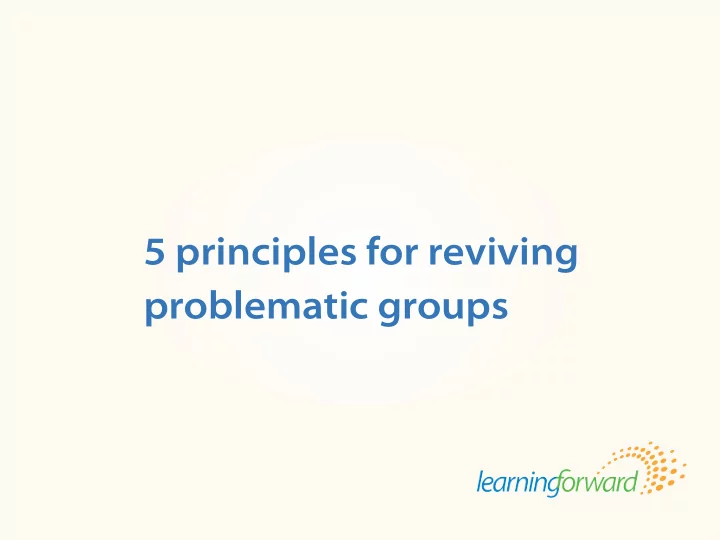

Title Body 5 principles for reviving problematic groups Source: Ermeling, B.A. (2012). Breathe new life into collaboration: 5 principles for reviving problematic groups. The Learning Principal. 8(1), pp.1, 4-5.
Unproductive and contentious meetings? Team-building activities = Changing attitudes before changing behaviors Behavior change, though, can lead to attitude change. Source: Ermeling, B.A. (2012). Breathe new life into collaboration: 5 principles for reviving problematic groups. The Learning Principal. 8(1), pp.1, 4-5.
1) Find a shared concern Find persistent student achievement challenges that a majority recognizes and shares. • Shared student needs can temporarily suspend old antagonisms. • Principals must create and prioritize time for the team to directly focus on identifying and addressing common student instructional needs. Source: Ermeling, B.A. (2012). Breathe new life into collaboration: 5 principles for reviving problematic groups. The Learning Principal. 8(1), pp.1, 4-5.
2) Establish teacher ownership Teachers must set and share the student-need goals themselves as they review available sources of evidence. • Others may suggest several key areas of need to choose from, but the goal chosen has to be one most teachers see as immediately relevant to their own classrooms. • Principals must keep at the forefront a team’s commitment to work together to develop instruction once a shared problem is identifjed. Source: Ermeling, B.A. (2012). Breathe new life into collaboration: 5 principles for reviving problematic groups. The Learning Principal. 8(1), pp.1, 4-5.
3) Get a commitment to meeting guidelines Empower teachers to hold colleagues accountable. • Principals must help teams establish, publish, and distribute their guidelines. • Review guidelines at strategic intervals by refmecting on meeting efgectiveness . Source: Ermeling, B.A. (2012). Breathe new life into collaboration: 5 principles for reviving problematic groups. The Learning Principal. 8(1), pp.1, 4-5.
4) Expect productive action Consistently engage in productive action. • Strive to collectively accomplish things that have a direct and positive impact on member teaching. • Principals must mentor the team leader to plan agendas and focus on the cycle of improvement. • Principals must monitor their own behavior so as to not raise other administrative topics or issues that might distract the team from their agenda and work. Source: Ermeling, B.A. (2012). Breathe new life into collaboration: 5 principles for reviving problematic groups. The Learning Principal. 8(1), pp.1, 4-5.
5) Strategize according to teams and individuals One-on-one attention may be necessary, even if all groups are struggling to work productively. • Keep the majority of teams moving forward through commitments to guidelines and establishing a framework and routine for successful action. • Principals can work directly with individual teams or team members where extra strategic attention is needed. Source: Ermeling, B.A. (2012). Breathe new life into collaboration: 5 principles for reviving problematic groups. The Learning Principal. 8(1), pp.1, 4-5.
ThE lEarNING EVEry EducaTor ENGaGEs IN EFFEcTIVE ProFEssIoNal lEarNING EVEry day so EVEry sTudENT achIEVEs Vol. 8, No. 1 • It’s time to take a Galilean approach to analyzing our data, p. 2 • For principals’ professional learning, overlap and modeling count, p. 3 • Tool: Principal refmection chart for reviving problematic groups, p. 6 • Tool: Gap analysis, p. 7 Download the article and accompanying tools Read the full article, published in Inside Principal Fall 2012 The Learning Principal (Fall, 2012). BREATHE NEW LIFE INTO COLLABORATION 5 principles for reviving problematic groups By Bradley A. Ermeling T he principal of a large urban middle school a critical choice point. Some might have suggested team- in the Midwest asked for my guidance as a building activities to exorcise the hostile social dynamics and download these tools: researcher and advisor to help make their standing in the way of efgective collaboration time — an ap- teams’ collaboration times more productive. proach that assumes attitudes must change before behavior Tie principal especially needed help with one changes. I assumed the opposite: behavior change is fol- teacher team whose meet- lowed by attitude change. ings were sufgocating from I asked, “Can we all tension and hostility. agree to suspend those be- When teachers on the haviors that are disrupting team were asked to de- productive work?” Heads scribe what happened dur- nodded, so I continued, ing collaboration times, “Tien let’s get started by many responses included developing an agenda.” such confrontational We started searching behaviors as shouting, for a common student poor listening, hostility, need, a pressing concern negativity, arguing about that the group thought Principal refmection chart for unimportant topics, and essential to meet for them reading uninformative to be successful. Turn- books. ing away from the highly When I met with abstract, philosophical the team, I made two observations: “One, you don’t like questions that had led to so much confmict was what this unproductive and contentious meetings, and, two, you group needed, not team building activities. would like to have meetings that are productive and focused Behavior change preceding attitude and belief changes on improving teaching and learning. Does anyone disagree is a staple narrative in literature, popular media, and with that?” personal anecdotes. Popular sports-themed movies often Tie room was quiet. Tieir silent agreement defjned Continued on p. 4 Your membership in Learning Forward gives you access to a wide range of publications, tools, and opportunities to advance professional learning for reviving problematic groups student success. Visit www.learningforward.org to explore more of your membership benefits. and Gap analysis Available at www.learningforward.org.
Learn more with Learn more about professional learning at all levels of education with Learning Forward , an international nonprofjt association of learning educators: www.learningforward.org Membership in Learning Forward gives you access to a wide range of publications, tools, and opportunities to advance professional learning for student success.
Recommend
More recommend